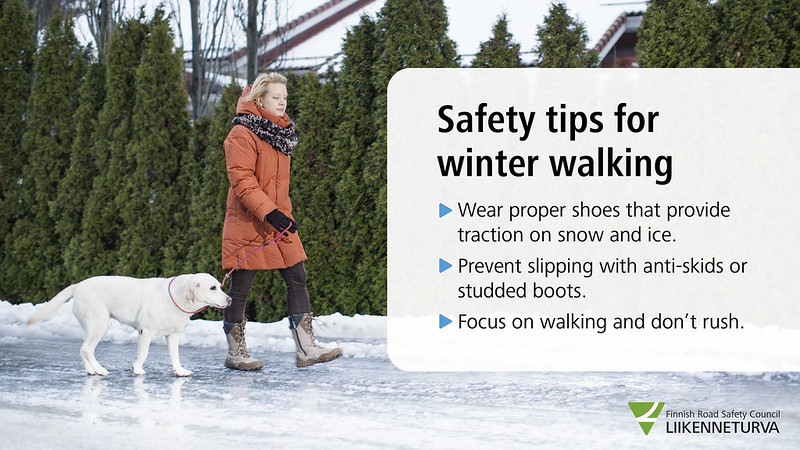Health care cannot handle unnecessary slipping injuries – do this to stay upright in slippery winter conditions
Most accidents on the way to and from work happen between November and March, when winter is at its most beautiful and road surfaces slippery. Compensation paid from employers' liability insurance due to falling down on the way to or from work amount to approximately 50 million euros each year*, and the costs don’t end there. Slippery road conditions are a challenge to health care, especially now that COVID-19 is putting an extreme burden on the health care system. Accidents caused by slipping are easy to prevent by being careful and making smart choices. The Pysy pystyssä campaign starting today provides you with tips on how to avoid slipping.

The cost of slipping and falling is too high
Compensation paid from the employers’ liability insurance for falling down while walking or biking to or from work amount to approximately 50 million euros each year.
”The indirect impact to employers, the injured and society are not accounted for in the amount of compensation paid. The true cost of the phenomenon is much higher. A significant share of accidents on the way to or from work while walking or biking lead to long periods of work disability,” says Database Analyst Janne Sysi-Aho from the Finnish Workers’ Compensation Center.
In wintertime, people fall down most often due to slipping. Slips occur especially when the mean temperature of the day is around zero degrees Celsius, which is when freezing and thawing occur frequently.
You can make a difference – stay in shape
Some people have exercised less during the COVID-19 pandemic. The lack of exercise makes it difficult to maintain balance in sudden situations that require speed. The older the commuter, the more the lack of exercise will affect the condition of their muscles and bones as well as their ability to react. Staying upright on slippery surfaces requires the ability to adjust one’s position quickly.
The consequences of slipping may be dire. Injuries to upper and lower limbs are especially common. If your bones fracture easily, you could be suffering from osteoporosis.
The UKK Institute recommends 2.5 hours of brisk exercise per week or 1 h 15 min of strenuous exercise per week combined with exercise to improve muscle strength, balance and flexibility at least twice a week to maintain health and functional capacity. The recommended amounts of activity can be accumulated from short periods of a few minutes’ activity during the week. Most importantly, your attentiveness will be decreased when you are tired or gloomy, increasing your risk of slipping.
Workplaces to contribute to not falling down
Anticipating risky situations is an efficient way of preventing slips and falls. Workplaces should also pay attention to this as part of occupational safety.
“On the way to and from work, you need to be extra vigilant in the parking areas at home and at work. You should provide feedback on the slipperiness of the walkways at work early on to help maintenance react to the conditions before anything happens,” stresses Occupational Physiotherapist Mari-Anne Wallius from the Finnish Institute for Occupational Health.
It is also very important to choose the right footwear or anti-slip guards for moving about in order to prevent slipping and injuries. If there is room in the budget, the employer may sponsor anti-slip guards for the staff or buy a bag of gritting sand.
“You should approach the selection of winter-time footwear with the same vigour as purchasing winter tyres. Shoes with a good grip, removable anti-slip guards, studded or high-traction shoes: there is a product for everyone,” says Planning Officer Laura Loikkanen from the Finnish Road Safety Council.
Seven ways to avoid slipping and falling
1. Wear shoes that are suitable for the road conditions.
2. Use anti-slip guards.
3. Make time for commuting.
4. Check the weather warnings for pedestrians
5. Give feedback to maintenance.
6. Stay in shape and keep alert.
7. Focus on walking.
*The Workers’ Compensation Center 2021.
The ‘Do not fall’ campaign period is 17–30 January 2022. Read more:
The ‘Pysy pystyssä’ website , The ‘Pysy pystyssä’ video on YouTube (in Finnish), Kotitapaturma on Facebook, Kotitapaturma on Twitter,
More information
On the campaign Saara Aakko, planning officer, Finnish Red Cross, +358 (0)40 4806 973, saara.aakko@punainenristi.fi
On accidents on the way to and from work Janne Sysi-Aho, database analyst, The Workers’ Compensation Center, +358 (0)40 4504 232, janne.sysi-aho@tvk.fi
On maintaining physical condition Mari-Anne Wallius, occupational physiotherapist, Finnish Institute of Occupational Health, +358 (0)30 474 3283, mari-anne.wallius@ttl.fi
On walking, commuting Laura Loikkanen, planning officer, Finnish Road Safety Council, +358 (0)20 7282 341, laura.loikkanen@liikenneturva.fi
The ‘Do not fall’ test (in Finnish): https://www.kotitapaturma.fi/pysy-pystyssa-testi/
The bones test (in Finnish): Luustoliitto.fi/luustotesti
Campaign partners: Aivovammaliitto, EHYT Finnish Association for Substance Abuse Prevention, Finance Finland, the Finnish Meteorological Institute, the Finnish Association of People with Physical Disabilities, the Finnish Road Safety Council, Luustoliitto, LähiTapiola, Nikander ja Wiinikka Oy, Partioaitta, Sarva studded shoes, the Finnish Ministry of the Interior, the Ministry of Social Affairs and Health, the Finnish Red Cross, Taitavat Suutarit ry, the National Institute for Health and Welfare, the Finnish Institute of Occupational Health.
Can you use the information on this page?
Give Feedback
With this form you can give us feedback.